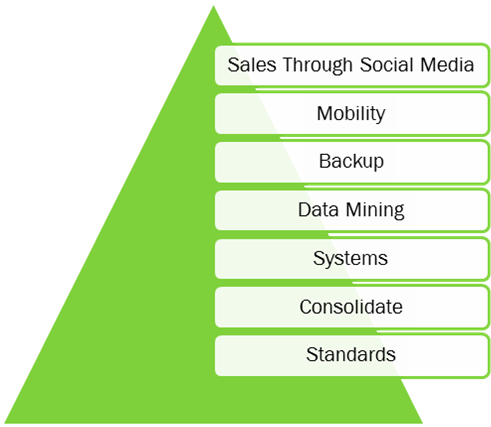While small business owners are often overwhelmed with a wide range of non IT issues from personnel to cash flow to supplier management, here are 7 ways owners are utilizing technology in business:

1. Develop standards
As small businesses proliferate, they often have multiple locations rolling out technology at different times. It is useful to develop some common technology standards. This enables economies of scale in purchasing, implementation, support and training. While it is important to be flexible, if every site is purchasing and implementing technology differently, there will be many and increasing inefficiencies.
2. Consolidate Infrastructure
As discussed in Small Business IT Virtualization and Storage Virtualization Benefits for Small Business IT, many small businesses are reaping the benefits of consolidating their infrastructire through virtualization. The traditional physical world which requires tremendous power, cooling, space and maintenace has yielded to the green and efficent virtual world. Small business owners are refreshing their technology with essentially cost-neutral projects based on these savings.
3. Implement systems that are built for bigger companies:
There is a temptation to just use what is necessary to get the job done with the least expensive tool, but the downside is that growth may make your IT systems bust at the seams. Think about systems that are designed for a company a multiple of your current run rate.
4. Have a strategy for getting information out of your systems:
Visibility in a small business is paramount. Some owners treat their businesses as lifestyle companies which is great, but if there are any aspirations for growth, developing rigor around forecasting is key. Information systems play a pivotal role in this. If you have followed the approach in item number 3, there are typically very powerful Structured Query Language (SQL) based capabilities in your systems that will allow for reporting on a wide variety of metrics such as backlog, sales forecast and expenses. These do not come for free, however. Appropriate business processes must be in place to ensure that the right data is going in and reports must be developed to leverage that data.
5. Have a backup
This has been touched on in 5 Ways To Complement IT Staff, but this is key. Once systems have been implemented and leveraged, there has to be a bullet proof way to recover from disaster. This is a very rich area of discussion and there are lots of things to consider including how much data needs to be backed up on and off-site, performance, data growth and cost. Some companies have terabytes of information because of client-related image and other media files. Others can squeeze critical data to tens of gigabytes.
6. Enable Mobility
While one form of virtualization consolidates infrastructure, another kind, application virtualization makes it widely available. Many businesses are implementing Remote Desktop Services (formally terminal services) to enable secure access to ther company resources from any device (PC, Macintosh, iPad, iPhone, etc.) that supports a Remote Desktop Protocol client. This is a boon for those in the business who cannot always be in the office and enables a standard, stable installation of applications rather than trying to install applications locally on every possible endpoint.
7. Use Social Media to Drive Marketing and Sales
Whil infrastructure technology is important, we should not overlook the advances in Internet-based capabilities that radically improve the way that small businesses can market and sell their products. Social media has changed the way that businesses operate and are a great way for small businesses to get additional leads very inexpensively. Search Engine Optimization (SEO) techniques and actively engaging in social media such as Facebook and Twitter are great complements to more traditional forms of marketing like direct mail and telemarketing. Sales organizations can more easily penetrate prospects by taking advantage of networking sites like LinkedIn.



